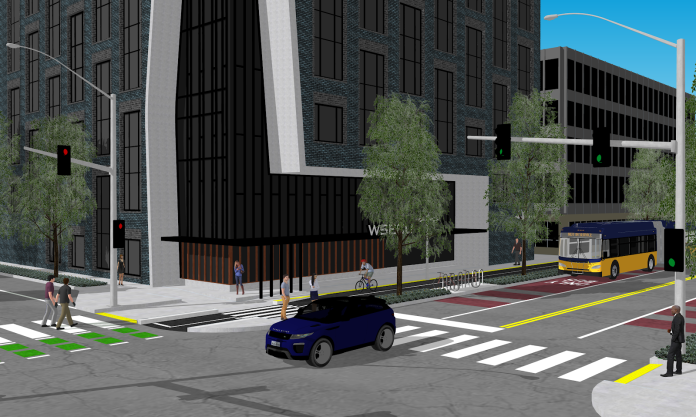
This 45th Street redesign would add protected bike lanes and put people rather than cars first.
Seattle’s NE 45th Street has long served as a highway collector for North Seattle drivers. Cutting through Wallingford to the west of I-5 and the University District to the east, the road serves a unique purpose as one of Seattle’s few major east-west arterials. However, NE 45th Street must rapidly change to keep up with the trajectory of the area. With University District light rail on track to open this year, with large upzones bringing new towers into the area, and with a series of U District streets possibly seeing full pedestrianization in the coming years, it is time that the city redesigns NE 45th Street.
The fact of the matter is that the vast majority of future light rail users will be arriving at the University District station by bus, bike, or foot—not by car. Thousands of those riders will also be new area residents drawn to recently-constructed and soon-to-open apartment complexes, just blocks away from high-quality rail service. And, new pedestrian streets would likely translate to a higher volume of pedestrians and cyclists in the area. It is vital that the city ensures the safety of pedestrians and cyclists, and the speed of bus service, throughout the corridor.
No longer should NE 45th Street be merely a highway collector and car sewer. When U District station opens later this year, it will be a magnet for local residents, University of Washington students, and people travelling from around Seattle to walk, roll, bike, and hop a bus to access the new light rail station. In anticipation of these changes, and in the face of the climate crisis, I propose (as have the Move All Seattle Sustainably (MASS) Coalition and The Urbanist), bus-only lanes along NE 45th Street—a big upgrade for Route 44. I also propose bi-directional protected bike lanes up and down the corridor—which would intersect with the protected bikes lane on Roosevelt Way—to connect area residents to future light rail service, existing and future businesses, and future pedestrian streets.
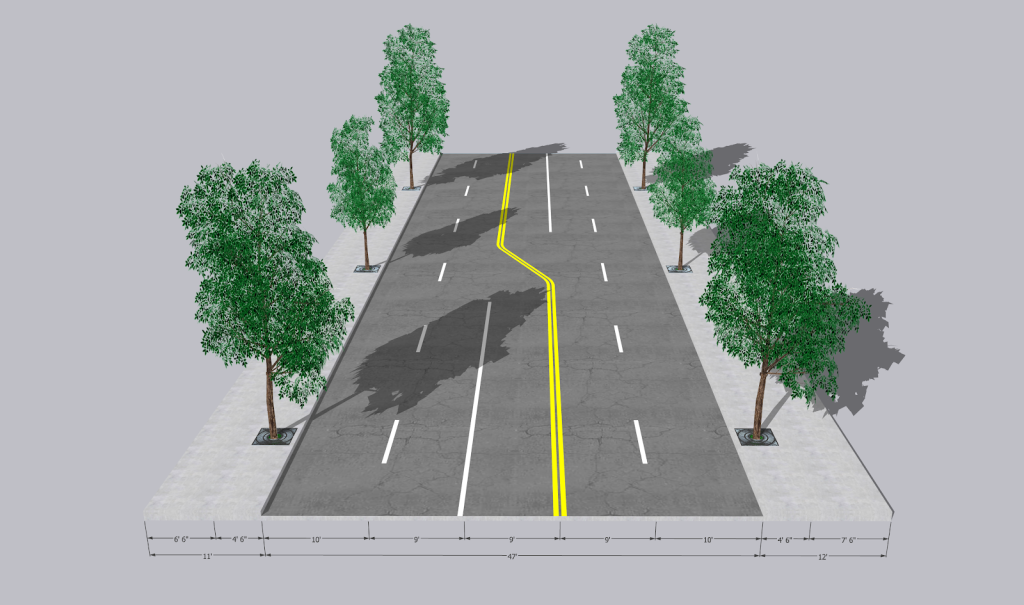
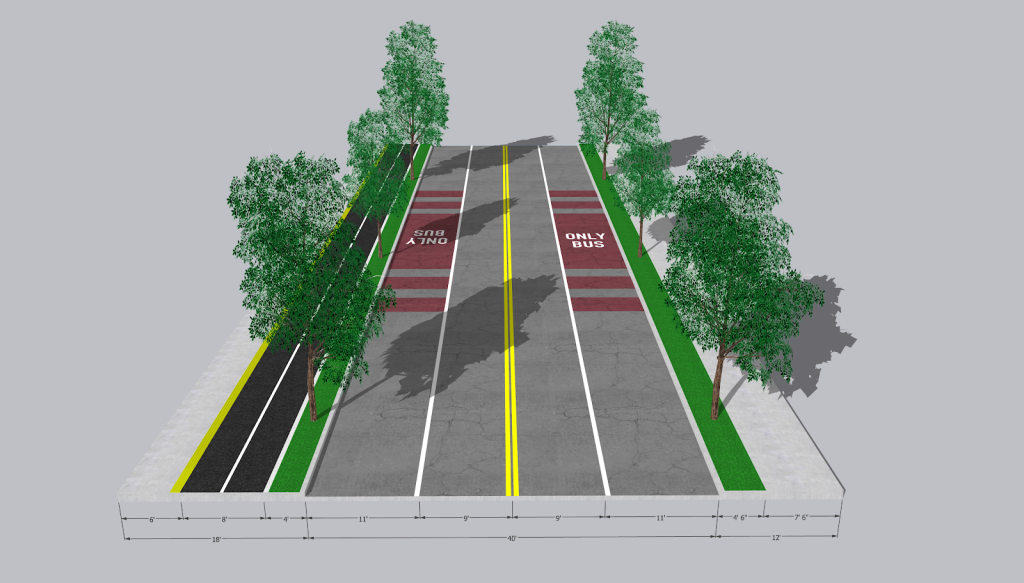
NE 45th Street is a highly constricted corridor. It is so constricted, in fact, that its center turn lane and two adjacent traffic lanes are an unusually narrow nine feet wide, compared to traffic lanes in the rest of the city that can range between 10 to 14 feet wide. The two curb-running lanes of the corridor are, currently, often just ten feet wide—a foot narrower than what is often standard for bus traffic. As such, envisioning a multimodal 45th Street can prove a challenge—but it’s far from impossible, as this article will show.
Because of the corridor’s constrained conditions, one-way bike lanes on both sides of the road would be extremely difficult to accommodate alongside bus lanes, sidewalks, and planting strips. A bi-directional bike lane, however, would be capable of servicing the corridor while leaving room for a substantial four foot wide planting strip to protect cyclists and pedestrians from general traffic. Even so, constrained conditions restrict the width of the bike lanes—National Association of City Transportation Officials (NACTO) standards recommend a total width of 12 feet for a bi-directional bike lane, but allow for a total width of just eight feet in the tight circumstances characteristic of NE 45th Street. This would allow bike traffic to be safely accommodated in both directions without sacrificing large amounts of existing sidewalk space or the ability to install bus-only lanes throughout the corridor.
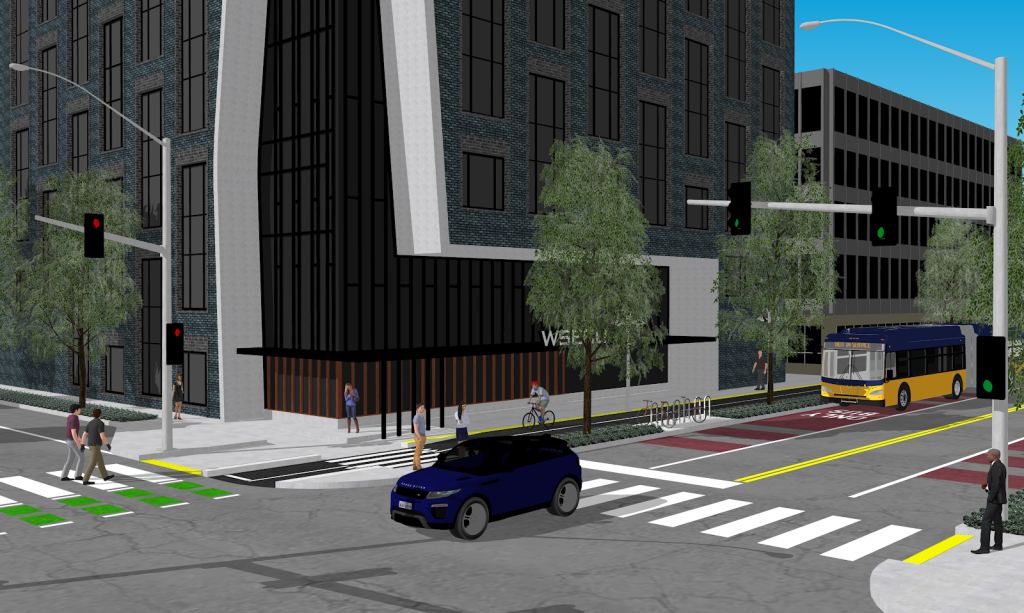
The space for the bike lanes can be found by eliminating the corridor’s center turning lane. Numerous intersections up and down the corridor through the University District already prohibit left turns despite the presence of the center turning lane. It eats up a great deal of space for car storage, and using that space to safely accommodate thousands of cyclists instead is the clear decision. The center turning lane is currently nine feet wide—meaning that the space could be repurposed to provide an eight-foot bi-directional cycle track while also contributing a foot to the planting strip that would buffer the lanes.
Because left turns are already largely prohibited up and down the corridor, and because many streets could be entirely closed to general traffic within the next few years, the typical threats to cyclists posed by bi-directional lanes—specifically, hazards from left and right-turning drivers not expecting contra-flow bike traffic—would be largely eliminated. If I had my way, we would pedestrianize The Ave, Brooklyn Avenue, and 12th Avenue (plus NE 43rd Street) to entirely eliminate threats to cyclists and pedestrians while creating a new car-free ecodistrict. This would also speed up eastbound Route 44 by allowing the line to move down NE 45th Street from 12th Avenue to 15th Avenue largely without obstruction from cars.
Bike lanes on NE 45th Street would provide a safe route for cyclists between Wallingford and the University District, expanding on the short sections of bike network the city has already installed on 45th—such as on the block running past Dick’s Burgers, between 1st and 2nd Avenue NE. The lanes would also intersect with substantial bike corridors, such as Roosevelt Way NE.
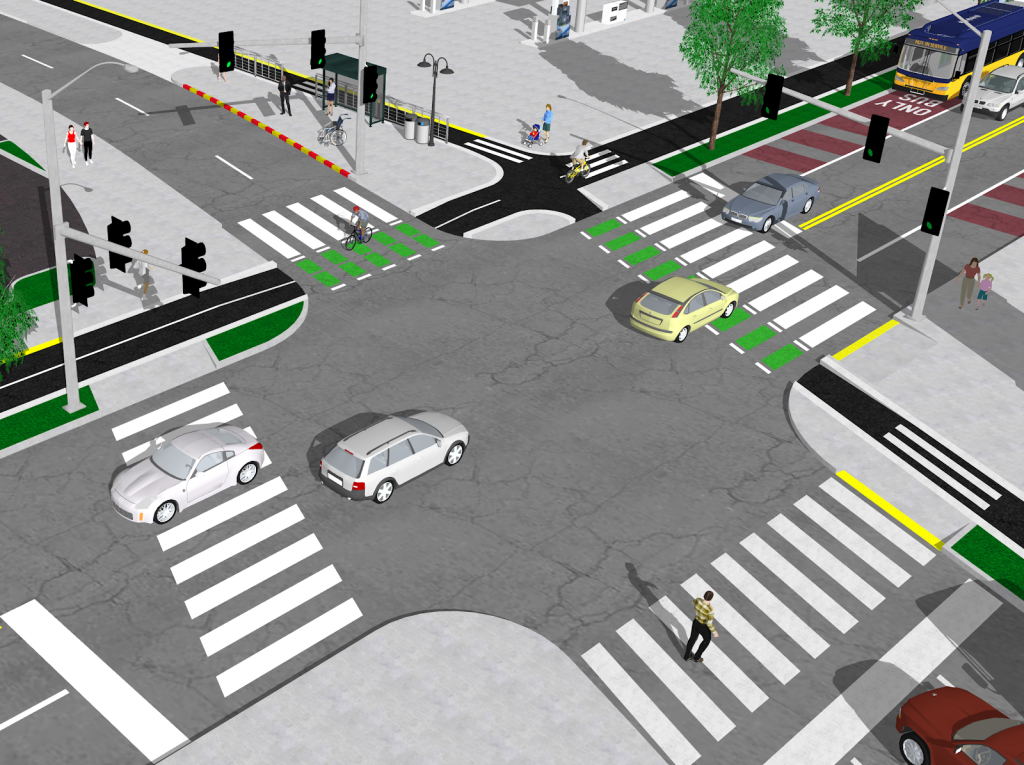
With the center turning lane out of the picture, precisely 40 feet of road width is left to work with. Just over half of that—22 feet or 11 feet per lane—could be used to swiftly shepherd transit riders throughout the corridor by rolling out the red carpet for new bus-only lanes. City surveys reveal that, for 93% of respondents, improving bus speeds in the corridor is the greatest concern. Bus lanes up and down the corridor (as I propose), in conjunction with traffic signal timing that gives buses preference at intersections, would provide the travel time reductions people want to see. This would rapidly speed up east-west bus service from Ballard to the University District—a big improvement for Route 44 riders—while also enticing new transit riders interested in commuting via light rail.
While I do not view reductions in car lanes and turning lanes to be a drawback of this proposal—I actually view those reductions as a step in the right direction towards a clean climate, safe streets, and a livable city—there are many that would not only view such a loss as a drawback, but would also likely be quite angered by the thought of eliminating lanes on NE 45th Street. The reality is that cars are an extremely inefficient mode of transportation. My proposal would be able to move up to 41,000 people per hour through the corridor, while the existing layout hits capacity at 26,000 trips—and, of the current road capacity, car lanes could handle only 8,000 potential trips per hour, while sidewalks handle the bulk of the remaining road capacity. The fact of the matter is that buses, bike lanes, and good sidewalk infrastructure can handle significantly more people per hour than cars alone ever could. Unfortunately, the city often attempts to build streets for cars alone, and then we wonder why we sit in traffic.
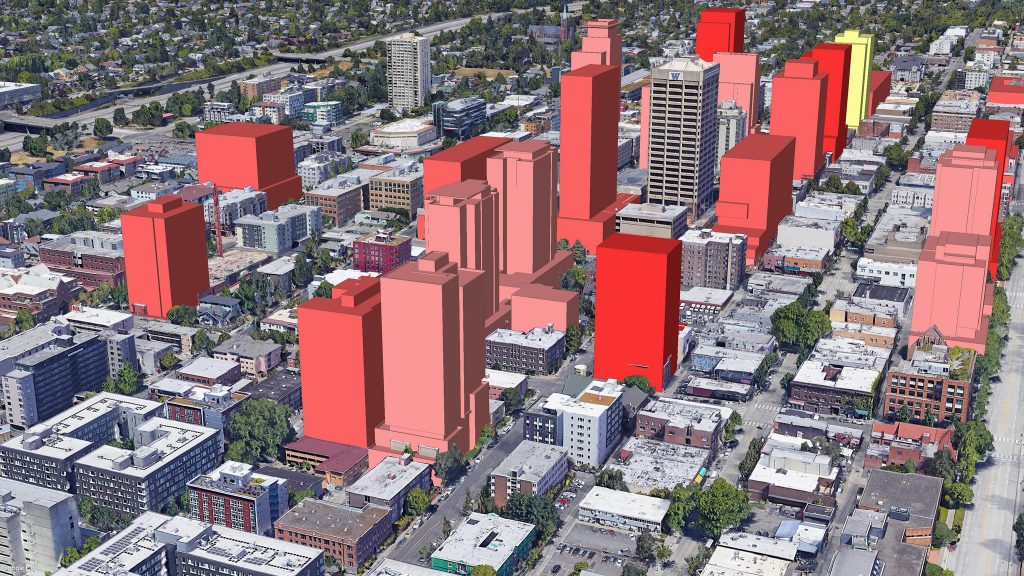
The other reality is that, like everything else in our world, roads have a demand, and a supply. With roads, however, increasing the supply induces demand. The fundamental rule of cities is that, “if you build it, they will come.” Building more lanes of traffic, under virtually all observed scenarios, translates to more cars on the road. With more lanes of traffic, travel times briefly drop, enticing new drivers, who then fill the new lanes. According to city planner Jeff Speck, new car lanes are almost automatically filled to 40% of their capacity by new cars. Within four years, new lanes reach 100% capacity. We could attempt to build our way out of traffic congestion with an infinite cycle of new car lane construction, but we would in the process pour thousands upon thousands of tons of concrete and spew millions of tons of emissions into the atmosphere. This approach is not just environmentally devastating, it is also unrealistic: it would require the large-scale purchase of property and demolition of existing housing stock to find the room for new lanes.
Thankfully, this is not the approach we ever will need to take. Just as demand for driving is induced by new car lanes, demand for cycling, walking, and transit riding is induced by new bus-only lanes and a safe bike and pedestrian network. And, a good transportation system alongside bike and pedestrian improvements can take on the road capacity that car lanes could never provide. As I once noted in my article outlining a safer NE 65th Street, “Cities are built around incentives, and good cities incentivize walking, biking, and transit—the transportation modes that most benefit traffic flow, businesses, the environment, public health, and safety.”
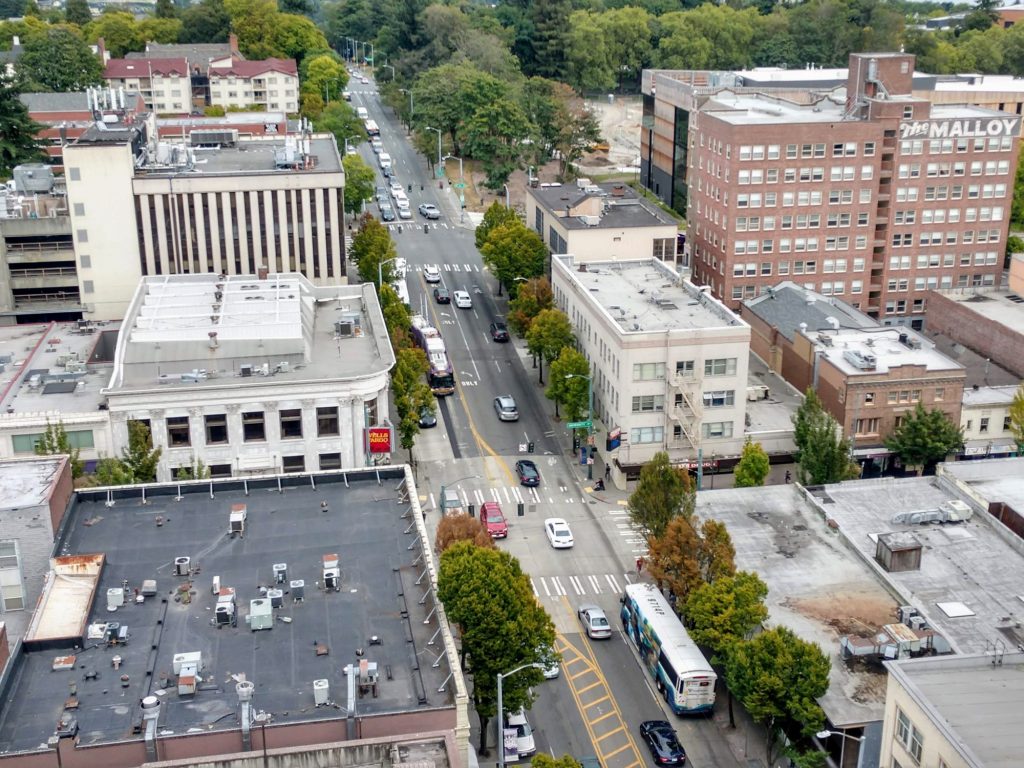
Improvements to NE 45th Street’s bus, bike, and pedestrian infrastructure are long overdue. The reality is that cars have outlived their usefulness. The time to build cities for people, not cars, was yesterday. Every year, 1.35 million people are killed in collisions involving cars. An additional 385,000 people lose their lives annually as a result of toxic air pollution from cars alone, and those emissions disproportionately impact communities of color. The average American spends the equivalent of two and a half work weeks every year in traffic, and studies show that pedestrian and cyclist-friendly streets encourage greater commerce at area businesses than streets built for cars. In cities across America, too, cars are a driving contributor of the climate crisis—in Seattle, 53% of the city’s overall emissions are the result of “cars and light duty trucks” alone.
We must ask ourselves: is it worth devoting 50% to 60% of our city space to the car—an invention that kills millions, destroys the planet, segregates communities, drives financial stress for working people, harms local business, renders city streets inaccessible for many people with disabilities, and costs taxpayers hundreds of millions of dollars annually? Or do we want a different future—one where everything you need is available within walking distance and where anyone, regardless of their income, can move about the city efficiently? We must end the dictatorship of the car, and the oppressive negotiation that is walking in urban America. We must move, immediately, to build a robust and efficient mass transportation network alongside critical bike and pedestrian infrastructure improvements. Our urban arteries are not immune.
With the United Nations urging drastic cuts to global emissions within the next ten years, and knowing that private cars contribute more than half of Seattle’s emissions, one must wonder why a city that prides itself on being a “climate leader” gets such cold feet when it comes to infrastructure investments that question the dominance of cars. Interestingly, pushback from angry drivers often borders on climate denialism—a stubborn unwillingness to recognize that we are rapidly destroying Earth, and that to confront this crisis we must set aside even our greatest conveniences and end our destructive ways of living.
Bus and bike lanes on NE 45th Street would advance Seattle’s transformation to a sustainable, just future. We must work to expand bus service and improve the efficiency of bus routes across the city. Closing off streets to create car-free ecodistricts, too, is but one critical solution in Seattle’s climate response. And, we must look to the city’s zoning laws to create communities that are dense, welcoming, and provide for the needs of all residents within a 15-minute walk. The climate crisis, and climate justice, cannot wait.
Joe Mangan (Guest Contributor)
Joe Mangan is an urban studies and political science double major at Vassar College. He organized the Seattle Climate Strike, led weekly strikes outside Seattle City Hall as the founder of Fridays for Future Seattle, and was later a coordinator with the Seattle for a Green New Deal campaign. His redesign of NE 65th Street was declared “Better Than SDOT’s” by the Seattle Bike Blog.
